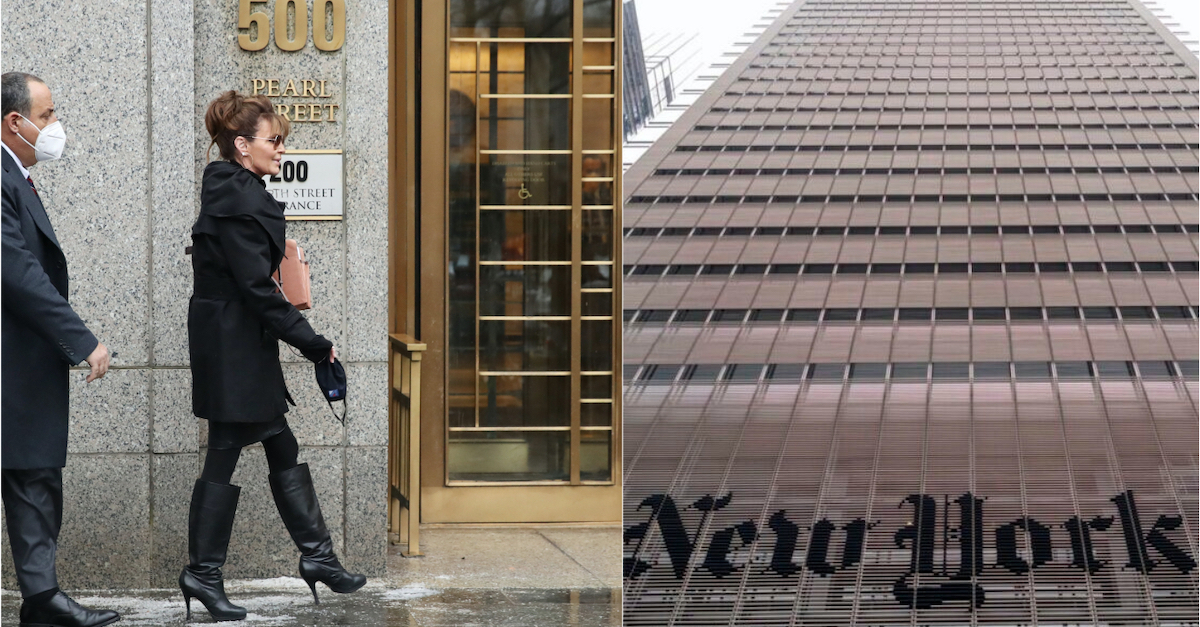
On the left, ex-Alaska Gov. Sarah Palin (R) enters into a Manhattan federal courthouse at 500 Pearl Street, where her lawsuit against the New York Times is taking place. The newspaper’s headquarters is on the right.
The day after a federal judge found that no reasonable jury could have found that the New York Times defamed former Alaska Gov. Sarah Palin (R), nine jurors who scrutinized the evidence reached the same conclusion.
On appeal, the not liable verdict will bolster Senior U.S. District Judge Jed Rakoff’s prior finding that Palin did not prove actual malice at trial. It also reinforces the Times’s unbroken record of victory in defamation cases in more than 50 years.
Palin claimed the Times libeled her in the 2017 editorial “America’s Lethal Politics. On her second day of testimony, Palin compared her defamation lawsuit against the U.S. paper of record as a David vs. Goliath battle. She compared her lawsuit to a stone.
The slingshot misfired twice in two consecutive days.
For the judge and the jury, the Times‘s speedy correction of two erroneous lines of an editorial after some 12 hours after publication did not a federal defamation case make. Palin did little to show that she was harmed by the nearly five-year-old editorial, either emotionally, financially or in terms of her career. Two days of testimony showed that she continued to rake in money from TV appearances, did not recall speaking to her family and friends about the column, and went out on the campaign trail with then-Senate hopeful Judge Roy Moore, in the wake of its publication.
Palin’s freely admitted that she’s heard that people have called her a “polarizing” figure, and Times attorney David Axelrod pointed out she even marketed merchandise with her motto: “Suck it up, cupcake.”
Axelrod pointedly threw those words back at her during summations with its better known variation: “You’ve got to suck it up, buttercup.”
Before it was corrected, the editorial asserted that the “link to political incitement was clear” when Jared Lee Loughner opened fire more than a decade ago in Tucson, Arizona, killing six people and injuring 13, including Rep. Gabrielle Giffords. The editorial board had been referring to a map disseminated by Palin’s political action committee Sarah PAC, which had stylized crosshairs over the electoral districts of Giffords and 19 other Democrats. No link was ever established between the shooting and the map.
Palin testified that the error was especially painful to her because she and her family received death threats in the immediate wake of the Loughner shooting. There was no testimony that these threats continued following the briefly-uncorrected Times editorial.
The Times does not dispute that dispute that they made an error, but their attorney Axelrod argued that their speedy correction showed the paper’s then-editors harbored no actual malice, a standard that has been law of the land in defamation cases since the watershed precedent in New York Times vs. Sullivan more than half a century ago.
“Freedom of the press and freedom of speech are fragile things,” Axelrod told a jury shortly before their deliberations on Friday afternoon.
Shortly before ending his summations, Axelrod added: “the First Amendment is so important that honest mistakes don’t create liability.”
Written in reaction to the 2017 congressional baseball practice shooting by James Hogkinson—who shot Rep. Steve Scalise (R-La.) and other Republicans—the editorial invoked the Loughner shooting some six years earlier as another example of a Congress member being victimized by gun violence. Axelrod argued that the Palin was something of a “footnote” to the original editorial, which criticized politicians across the aisle.
The editorial, which even praised Donald Trump, noted that Hodgkinson was a supporter Sen. Bernie Sanders (I-Vt.).
Palin’s attorney Kenneth Turkel claimed then-Times editor James Bennet “hated” his client because of his politics, but there was little evidence of that at trial. Bennet apologized to Palin during his testimony, and Judge Rakoff threw out Palin’s claim of punitive damages, finding evidence of Bennet’s ill will is “quite modest indeed.”
Bennet rewrote the unsigned editorial, and the initial draft, written by Elizabeth Williamson, did not include the disputed language. It was not Bennet’s decision to even refer to Palin in the original editorial, and internal Times communications showed that they scrambled to quickly correct the story amid criticism.
During her testimony, Palin acknowledged that she did not request a correction or apology at any point after it ran on June 14, 2017, one day after the congressional baseball practice shooting. She posted that she was “exploring options” on a lawsuit on Twitter the next day.
Rakoff previously said he expected any verdict “will inevitably go up on appeal.”
(Photo of Palin via Spencer Platt/Getty Images; photo of NYT building via JOHANNES EISELE/AFP via Getty Images)